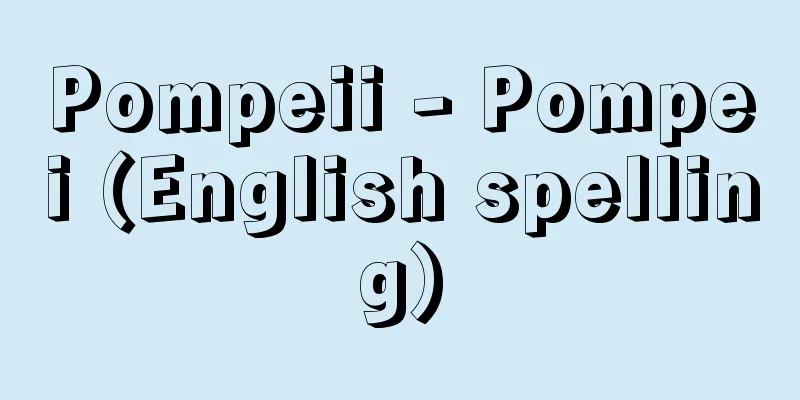Pompeii - Pompei (English spelling)

|
Pompeii is an ancient city located in southern Italy. It is now in the Province of Naples, Campania, 23 km southeast of Naples, and the entire ancient city of Pompeii is preserved as an ancient ruin to the west. In 1997, it was registered as a World Heritage Site along with the ruins of Herculaneum and Torre Annunziata (World Cultural Heritage). [Nobuo Matsumoto] historyThe fertile land on the southeastern foot of Mount Vesuvius, close to the Bay of Naples and an important transportation point, was settled by the Oscans, the indigenous people of Italy, in ancient times. Greek colonists arrived in the 8th century BC, and in the 7th century BC, Etruscans also migrated, and it grew into a city-state and an aristocratic republic. Greek temples were built and the number of houses increased. It prospered by producing a lot of grapes, agricultural products, fish and shellfish, and exporting pumice. In the 5th century BC, it was robbed by the Samnites who lived in the mountains, and was eventually occupied. However, Oscan-Greek culture was rather dominant, which is reflected in the mosaics in the squares and houses, and the city area expanded and a wall was built. Later, it came under Roman control as Rome advanced, but during the Second Punic War, it sided with Hannibal of Carthage. Furthermore, during the War of the Leagues (91-88 BC), the city resisted Rome and gained Roman citizenship, but was eventually submitted to Roman rule. Many veterans from the side of the influential Roman leader Sulla settled the city, and the city was named after Sulla's family name. After that, the city rapidly became Latinized and Romanized, and the city council system was established. Wealthy Romans liked to build villas, and theaters, temples, basilicas, baths, triumphal arches, colonnades, and shops were built one after another. Trade with the East, such as Greece and Alexandria, continued, and worship of Oriental gods such as Isis was popular. Artists and craftsmen gathered and worked hard to decorate mansions and public buildings. At its peak, the city had a population of 15,000 to 20,000, making it one of the most magnificent cities in Campania. Even during the Imperial period, it continued to prosper as a resort, and waterworks and paved roads were developed. However, after a major earthquake in February 63 AD, the residents were in a state of anxiety, and on August 24, 79 AD, Mount Vesuvius erupted. A large amount of volcanic ash and lapilli fell on Pompeii, burying the entire town. It is estimated that 2,000 people died. After that, Pompeii was never rebuilt and was forgotten. The reason for its abandonment is said to be that the city had already passed its prime by that time. [Nobuo Matsumoto] Excavations and ruinsIn the mid-16th century, the existence of an ancient city buried under the ground was discovered, and excavation began in 1748. The excavation has revealed amazingly clear facts about urban life in ancient Rome. Currently, 80% of the city has been excavated, and the city has been restored as a huge archaeological park, exactly as it was just before it was buried under volcanic ash. In addition to large buildings such as the temples of Apollo, Venus, and Jupiter surrounding the Forum (square), the large and small theaters in the triangular square, and the great arena that can accommodate 15,000 people, there are valuable buildings such as streets with separate roads and sidewalks and even crosswalks, grocery stores, and taverns. Also notable are the luxurious appearance of the mansions of the wealthy, such as the house of the wealthy merchant Vettii and the house of the tragic poet. In particular, a gorgeous mural of the Mysteries of Dionysus has been discovered in the Villa of the Mysteries on the outskirts. Other remains unearthed include people and dogs who were unable to escape, tables where people were eating, various foods, medical equipment, toys, posters, and other everyday items, making Pompeii a treasure trove for learning about the lives of ancient Romans. The ruins are under the jurisdiction of the Archaeological Institute, and excavations continue, attracting many visitors. Many of the excavated items, including a mosaic of Alexander the Great, are kept at the National Museum in Naples. The town currently has a population of 25,751 (2001 census preliminary figure), and has a church that is a sacred place of pilgrimage, mineral springs, a volcano observatory, and a food industry. [Nobuo Matsumoto] "World Cultural Historical Sites: Rome and Pompeii" edited by Go Shigekazu (1968, Kodansha)" ▽ "Pompeii" by Corti, translated by Matsutani Kenji (1964, Misuzu Shobo) The ruins of a city discovered in the mid-16th century. It is a valuable ruin that tells us about urban life in ancient Rome, and the appearance of the city just before it was buried under volcanic ash has been preserved exactly as it was. Part of the World Heritage Site "Archaeological Areas of Pompeii, Herculaneum and Torre Annunziata" (registered in Italy in 1997) Near Naples, Italy ©Shogakukan "> Ruins of Pompeii The gladiators' quarters adjacent to the Great Theater. There are several partitioned rooms along the perimeter. Part of the World Heritage Site "Archaeological Areas of Pompeii, Herculaneum and Torre Annunziata" (Italy, registered in 1997) Near Naples, Italy ©Masashi Tanaka "> Pompeii ruins: House of the Gladiators An open-air theater that can accommodate approximately 5,000 people. Part of the World Heritage Site "Archaeological Areas of Pompeii, Herculaneum and Torre Annunziata" (registered in Italy in 1997) Near Naples, Italy ©Masashi Tanaka "> Pompeii ruins: "Great Theatre" A street with a clear distinction between the roadway and the sidewalk. Car tracks remain on the roadway. Initially, crushed stone was laid, but from the 4th century BC, stone slabs became widespread. Part of the World Heritage Site "Archaeological Areas of Pompeii, Herculaneum and Torre Annunziata" (Italy, registered in 1997) Near Naples, Italy ©Shogakukan "> Ruins of Pompeii (street) Source: Shogakukan Encyclopedia Nipponica About Encyclopedia Nipponica Information | Legend |
|
イタリア南部にあった古代都市。現在のカンパニア州ナポリ県、ナポリの南東23キロメートルに同名の町があり、その西方に古代のポンペイの町全体が古代遺跡として保存されている。1997年にエルコラノ、トッレ・アヌンツィアータの遺跡とともに世界遺産の文化遺産として登録されている(世界文化遺産)。 [松本宣郎] 歴史ベスビオ火山南東麓(ろく)の肥沃(ひよく)な土地で、ナポリ湾に近く交通要地でもあったために、古くイタリア先住のオスク人が集落をつくっていた。紀元前8世紀にはギリシアの植民者が来住し、前7世紀にはエトルリア人も移住して都市国家に成長し、貴族共和政となったと考えられている。ギリシア神殿ができ、家屋も増えた。ブドウや農産物、魚貝類を多く産し、軽石などをも輸出して栄えた。前5世紀には山地に住むサムニウム人の略奪を受け、ついには占領された。しかしオスク・ギリシア文化がむしろ優勢で、広場や家屋のモザイクにそれが表れ、市域も拡大し城壁がつくられた。のちローマの進出によりその支配下に入るが、第二次ポエニ戦争時にはカルタゴのハンニバルに味方した。さらに同盟市戦争(前91~前88)でもローマに抵抗し、ローマ市民権を獲得したものの結局ローマの支配に服し、ローマの有力者スラの派の退役兵が多数植民して、都市の名もスラの家名を付してよばれるようになった。 以後急速にラテン化、ローマ化が進み、都市参事会制度も整った。ローマの富裕者が好んで別荘をつくり、劇場、神殿、バシリカ、浴場、凱旋(がいせん)門、柱廊、商店が続々と建設された。ギリシアやアレクサンドリアなど東方との通交も続けられ、イシスなどオリエントの神々の崇拝も盛んで、芸術家、職人も集まり、邸宅や公共建築の装飾に活躍した。最盛時の人口は1万5000~2万を数え、カンパニアでも有数の壮麗な都市となった。帝政期に入っても保養地として繁栄を続け、水道や舗装路も整備された。しかし、紀元後63年2月に大地震に襲われ、住民が不安に陥っていたところ、79年8月24日ベスビオ火山が大爆発をおこした。ポンペイには大量の火山灰、火山礫(れき)が降り注ぎ、町全体が埋没した。死者は2000人と推定される。その後ポンペイは二度と復興されることなく忘れ去られた。当時のポンペイが都市としての盛期を過ぎていたことが、放棄された理由とされる。 [松本宣郎] 発掘と遺跡16世紀なかばになって、土に埋もれた古代都市の存在が発見され、1748年に発掘が開始された。発掘に伴って、古代ローマ時代の都市生活の実態が驚くほど明瞭(めいりょう)にされてきた。現在は8割が発掘され、巨大な遺跡公園として、火山灰に埋もれる直前の街のたたずまいがそのまま再現されている。フォルム(広場)を囲むアポロ、ウェヌス、ユピテルの各神殿、三角広場の大小の劇場、1万5000人収容の大闘技場などの大建築に加え、車道と歩道が区別され横断歩道すらある街路、食料雑貨の小売店、酒場などの貴重な建物がある。また裕福な商人ウェッティの家、悲劇詩人の家など富豪の邸宅の豪奢(ごうしゃ)なようすも目だち、ことに郊外の秘儀荘の家からは華やかなディオニソスの密儀の壁画が発見されている。そのほか、逃げ遅れた人間や犬、食事中のテーブル、さまざまな食物、医療器具、遊具、ポスター、その他日常品なども多数発掘され、ポンペイはまさに古代ローマ人の生活を知るための宝庫となっている。遺跡は考古学研究所の管轄下にあって発掘が続けられる一方、多くの見学者を集めている。アレクサンドロス大王のモザイクなど多くの出土品は、ナポリの国立博物館に収められている。現在の町は人口2万5751(2001国勢調査速報値)で、巡礼の聖地をなす教会、鉱泉、火山観測所などがあり、食品工業が行われる。 [松本宣郎] 『呉茂一編『世界の文化史蹟 ローマとポンペイ』(1968・講談社)』▽『コルティ著、松谷健二訳『ポンペイ』(1964・みすず書房)』 16世紀なかばに発見された都市遺跡。古代ローマ時代の都市生活のようすをいまに伝える貴重な遺跡で、火山灰に埋もれる直前の街のたたずまいがそのまま保存されている。世界文化遺産「ポンペイ、エルコラノおよびトッレ・アヌンツィアータの遺跡地域」の一部(イタリア・1997年登録) イタリア ナポリ近郊©Shogakukan"> ポンペイの遺跡 大劇場に隣接する剣闘士たちの宿舎。外周に沿って、仕切られたいくつかの部屋がある。世界文化遺産「ポンペイ、エルコラノおよびトッレ・アヌンツィアータの遺跡地域」の一部(イタリア・1997年登録) イタリア ナポリ近郊©Masashi Tanaka"> ポンペイの遺跡「剣闘士の館」 およそ5000人を収容できる野外劇場。世界文化遺産「ポンペイ、エルコラノおよびトッレ・アヌンツィアータの遺跡地域」の一部(イタリア・1997年登録) イタリア ナポリ近郊©Masashi Tanaka"> ポンペイの遺跡「大劇場」 車道と歩道が区別されている街路。車道には車の轍が残る。初めは砕石が敷かれたが、紀元前4世紀から石板による舗装が普及した。世界文化遺産「ポンペイ、エルコラノおよびトッレ・アヌンツィアータの遺跡地域」の一部(イタリア・1997年登録) イタリア ナポリ近郊©Shogakukan"> ポンペイの遺跡(街路) 出典 小学館 日本大百科全書(ニッポニカ)日本大百科全書(ニッポニカ)について 情報 | 凡例 |
<<: Pompey - Gnaeus Pompeius Magnus
Recommend
Antipode
...When a molecule or polyatomic ion cannot be su...
dihqān (English spelling) dihqan
…The establishment of the Zoroastrian Church mean...
Pease, FG (English spelling) PeaseFG
...The size of a celestial object can be calculat...
Eurameria
…Insects flourished remarkably, and the dragonfly...
Merger processing - Gappei Shori
… [Types of sewerage] Japan's sewerage system...
Christmas
…Christmas means the mass of Christ in English. T...
Dry keratoconjunctivitis - Keratoconjunctivitis Sicca
[What kind of disease is it?] The cornea and conju...
Phrynops
…Eggs are laid in holes dug on the shoreline, wit...
great skua (English spelling) greatskua
...All three species are seen passing through the...
Atayal
...However, scholars differ in opinion as to the ...
Craft guild - Shukougyouguild (English spelling)
A craftsman's guild formed within medieval Eur...
Katai Tayama
Novelist. Born on December 13, 1871 in Tatebayash...
Treaty of Waitangi
A treaty signed in 1840 between the British govern...
Toledo (English spelling) Toledo, Alejandro
Born March 28, 1946. Cabana, Peruvian politician a...
wolf (equal temperament) (English spelling) wolf
…This allows for the first time enharmonic modula...









